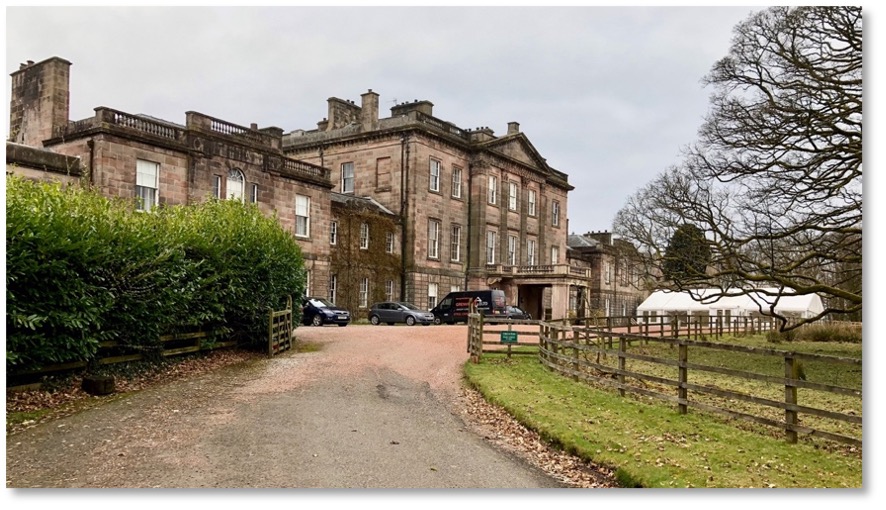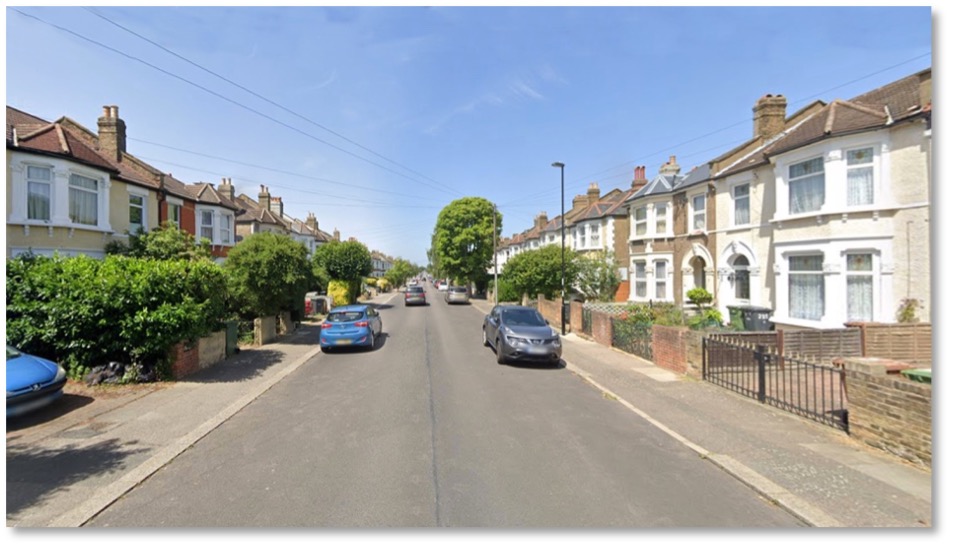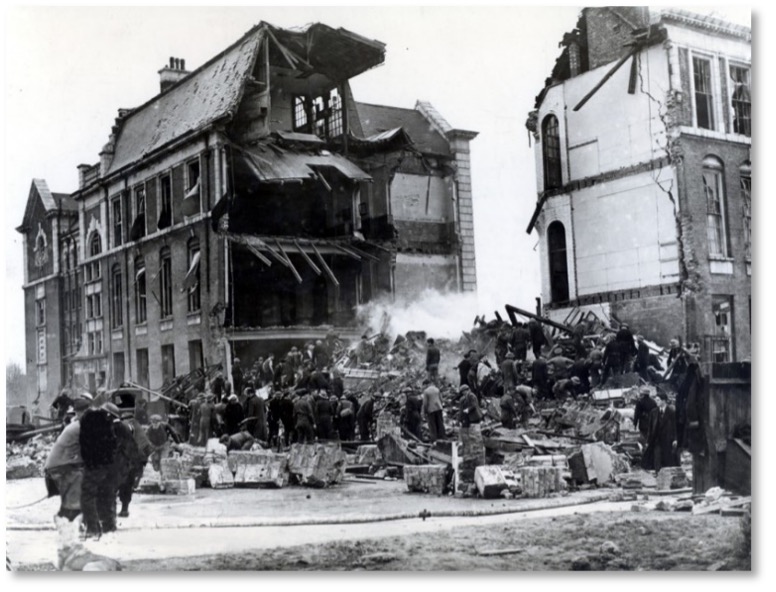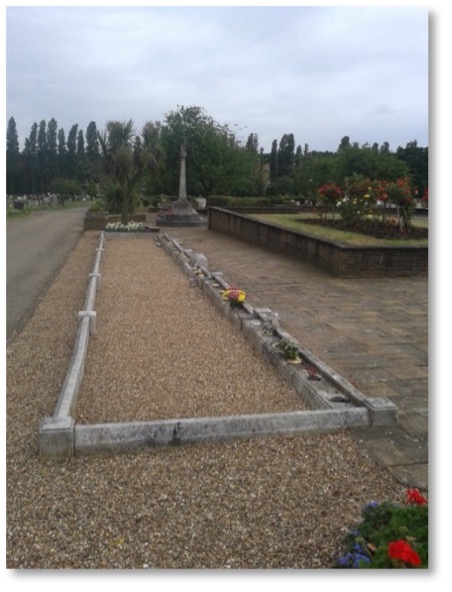“Scene of an historic but tragic event”
Unlike many roads on the Corbett Estate, which take their name from a village or town in Scotland, Ardgowan Road was named after a large country mansion.
Over the course of 800 years, Ardgowan House has evolved from a solitary watchtower to a modern Country Estate. It has seen battles and witch hunts, Napoleonic adventures and Wartime bombings. Encounters with Robert the Bruce, Napoleon and Florence Nightingale are all woven into the House’s colourful history.
It stands near the Firth of Clyde, about 32 miles west of Glasgow, and is just up the road from where Archibald Corbett got married in the village of Skelmorlie. It’s no surprise that a man who loved big houses and grand architecture would have wanted to celebrate the name of Ardgowan in his own Estate in London.

Ardgowan House on the west coast of Scotland
Ardgowan Road is one of the longest on the Corbett Estate. It is in the heart of the Estate and runs from Hither Green Lane (on the north side of the South Circular Road) to Hazelbank Road in the South. The Road spans three others; Brownhill Road, Sandhurst Road (near to Sandhurst School) and Dowanhill Road.

Ardgowan Road in the Corbett Estate
Building of the street commenced in 1898, and when it was finished there were 230 houses. The 1911 census recorded 952 people residing in the road. That equates to 4.1 people per house – a mid-range average occupancy rate on the Estate.
There was a small parade of eight shops/businesses. Back in 1911 the shop at No. 145 was a Greengrocers, run by William Gosling. At No. 149 William Bedwell ran a Fruiterer and Greengrocer; at No. 151 Harriet Radford had a small clothing business; then at No. 155 we had George Cook, a Dairyman; next door to George was a Butchers run by Arthur Bowers; and finally at No. 159 there was a post office run by Sub Postmaster Frederick Hall (who also lists his occupation as ‘Oil and Colourman’, so he clearly had more than one string to his bow). Sadly the Post Office and two or three of the shops have now been turned into flats, a fate which many on the Estate have faced.
The Early Residents: details from the 1911 Census
Ardgowan was one of the most female-orientated of the 27 streets on the Estate, with 55% of the residents being women and girls, and 45% men or boys. The Estate average was 53% female and 47% male.
The top two most popular adult female first names here were Mary and Elizabeth, with the male equivalents being George and William. For children, it was Doris and Frederick.
As with almost every other street, the most popular kind of work for the citizens of Ardgowan Road was as a Clerk. Of the 359 people in employment, 78 said that they did some sort of office job (Clerk). Amongst the non-office workers, there was Rudolf Weber, a 39 year-old ‘Furrier Dealer’ at No. 93 (effectively someone who buys and sells furs); Arthur Johnson, a ‘Shunter SC & CR’ at No. 183 (a Shunter was a person who arranged the position of railway rolling stock, and this would have been an ideal job as he lived local to Hither Green Station); and 14 year-old James Fichen residing at No. 133 who described himself as a ‘Tripe Dresser’. James was basically a Butchers boy who prepared tripe for sale.
The street’s prize for the highest number of children in a family was split four ways: the Murch family at No. 1, the Archer family at No. 204, the Dutch family at No. 209 and the Creasey family at No 214 all had six children. This means there were at least 8 people living in those houses.
At No. 168 lived Catherine Gregory who takes the prize for ‘resident from furthest away’: she was from Melbourne, Australia. Overall, the vast majority of the street’s residents (70%) had been born in London (a little lower than the Estate average of 72%).
The oldest resident at the time of the 1911 census was Philip Greet, a retired Engine Fitter who lived at No. 160 with his daughter Annie and her husband William. He was 80 years old.
A shattering blow
The bombing of Sandhurst Road School (between Ardgowan and Minard Roads) is almost certainly the most infamous of all events on the estate. It occurred during an air raid on Wednesday, 20th January 1943 when Sandhurst school (main entrance on Minard Road) was seriously damaged. A German Fighter Bomber dropped a single 500-kilogram (1,100 lb) bomb on the school at 12:30 pm, killing 38 children (32 killed at the school and 6 more died in hospital) and 6 staff. Another 60 people were injured. Many were buried for hours under the rubble.
The attack:
The German attack was part of a raid by 28 Focke-Wulf Fw 190A-4U3 fighter-bombers escorted by Messerschmitt Bf 109 fighters, which took off at noon from an airfield in German-occupied France. The planes were to attack any targets of opportunity in what the Germans called a Terrorangriff (“terror raid”).[2] The German pilot who attacked the school was Hauptmann Heinz Schumann (born 29 November 1914, killed in action 8 November 1943) from Jagdgeschwader 2. He was flying a Focke-Wulf Fw 190A-4 carrying a single 500 kg SC500 bomb. It is debated whether Schumann deliberately targeted the school, or simply attacked what looked like a large factory (the school was several stories high). The report mentions that a large building was targeted and destroyed in the raid and noted as a block of flats. Goss also says that the RAF had bombed Berlin three days before this terror-raid which was a retaliation raid demanded by Hitler.

This photo was taken shortly after the attack, from the Sandhurst road side
Due to inefficiencies of the warning system, the air raid siren had not sounded by the time the German planes arrived. Many children were having their lunch and the attack destroyed the area of the school where they were eating. Witness reports suggest the attacking planes first flew past the school and then bombed it on a second run.
The bomb killed (either immediately or later in hospital) 24 pupils and 2 teachers in the dining room. Five more children were killed on a staircase and nine in second floor classrooms. The blast also destroyed the staffroom killing three teachers and another was killed in a science room. Roughly 60 others were injured. The teachers who died were Mrs Connie Taylor, Mrs Ethel Betts, Mrs Virginia Carr, Miss Mary Jukes, Miss Gladys Knowelden and Miss Harriet Langdon.
Of the 38 children and 6 teachers killed by the bombing, 31 children and 1 teacher were buried together at Hither Green Cemetery in a civilian war dead plot. The mass grave has a rectangular stone surround and contains a raised tablet with inscription. Over 7,000 mourners attended. The school has both a stained glass window and a memorial garden in memory of those who died. Memorials from the children of the USA and the children of Mexico can be found in Saint Andrew’s Parish Church and the Chapel at Lewisham Cemetery respectively. Interestingly, one of the clergy in attendance after the bombing was Fr Hubert Brazier, Curate at Saint Andrew’s, and father of the former Prime Minister, Teresa May. In a letter on the 75th anniversary of the bombing Mrs May wrote: “I know that the terrible loss of life at the school weighed heavily on my Father, and always remained with him”.

Mass grave and memorial to the victims of the bombing of Sandhurst School at Hither Green Cemetery
The aftermath
Shortly after the raid, an inquiry into the events surrounding the attack and the responses of the emergency services was held at Lewisham Town Hall. It was noted that local Civil Defence Services arrived at the school quickly and special thanks were made to volunteers, the Heavy Rescue Squads, REME soldiers billeted at St Dunstan’s College and Canadian forces from Bromley Wood. Some issues were raised about how the Police were unable to control parents at the school digging for their children but given the nature of the incident this was noted to have been impossible to prevent.